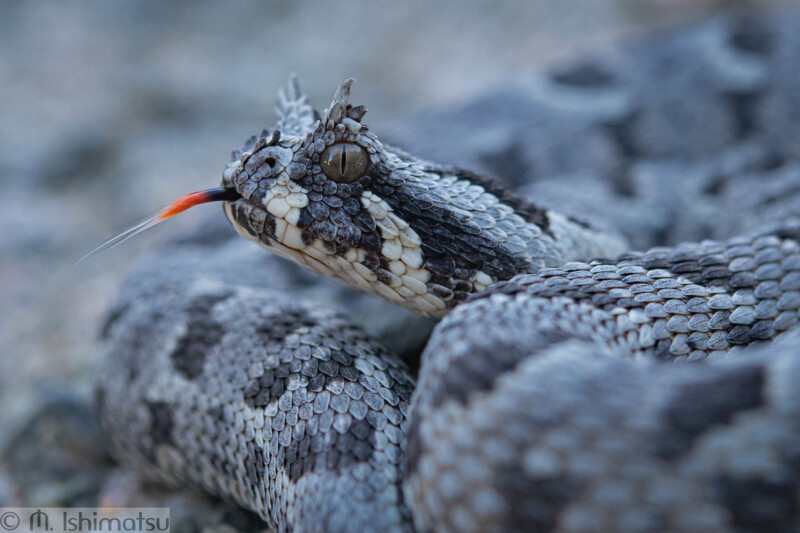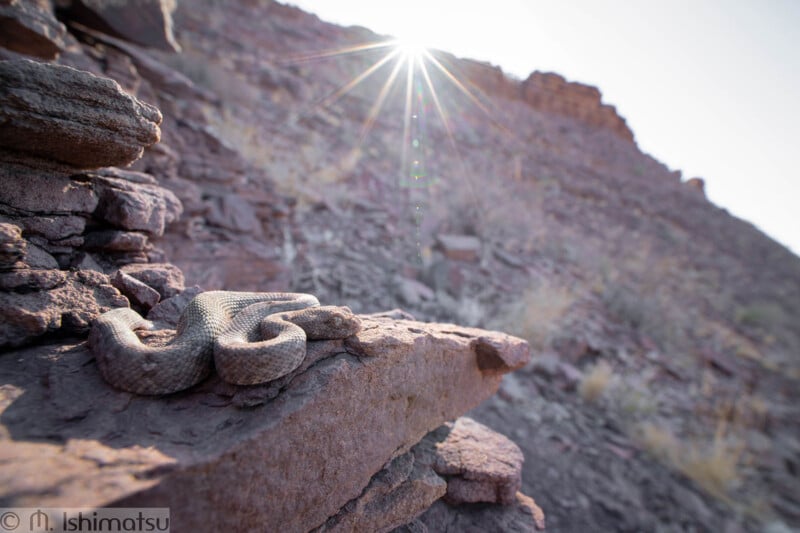A photographer traveled to Namibia to capture well-camouflaged snakes that exclusively live in the sub-Saharan African country.
![]() Peringuey’s adder
Peringuey’s adder
Marisa Ishimatsu captured magnificent photos of a Peringuey’s adder who are perfectly adapted to hide themselves in the soft sands of the Namibian desert.
“They sidewind effortlessly across the dune slopes and they bury themselves in soft sand at the base of bushes, both to ambush lizards and to protect themselves from predation,” Ishimatsu tells PetaPixel.
“Their eyes are on the top of their heads and their nostrils are reinforced and on the top of their nose so when they are completely buried, they can still see and breathe.”
![]()
![]()
![]()
Ishimatsu went with a group from Europe and the United States who wanted to find all of the dwarf adder species that inhabit Namibia. There are six species of viper in the country.
“Like my friend, most of my vacations are spent looking for snakes and other wildlife all over the world so searching for these animals in Namibia sounded like an excellent time,” she says.
The crew hired Dayne Braine from The Naturalist Collection who helped them find the elusive snakes.
“With Dayne’s help and knowledge, we found all six of the species of viper so we accomplished exactly what we went there to do,” says Ishimatsu.
“From a photographic perspective, I don’t think I could ever capture everything I wanted to in Namibia, but I am incredibly proud of the shots I captured.”

![]()

The photographer used her Nikon D850 to capture amazing imagery of not just the Peringuey’s adder, but other vipers too.
“The trip was incredible. Namibia is a beautiful country, and I found myself taking photos of everything — from the plants to the invertebrates to the snakes and the charismatic megafauna,” adds Ishimatsu.
Snake Photographers’ Duty
This past weekend saw the Sweetwater Rattlesnake Roundup where thousands of snakes are hunted and brought to the jamboree where they are killed.
Snakes have been demonized and vilified for eternity, something that Ishismatsu would like to see change.
“Snakes are an important part of our ecosystem, and yet they are often overlooked except for the dedicated few of us who love to photograph them,” she says.
“Snake photographers feel that it is our duty to show the beauty of these animals — to foster a sense of curiosity and respect and not fear — to ensure these animals are protected.”
Ishimatsu says that her social media feeds are filled with wonderful photos of birds, flowers, and mammals — but not snakes. “It’s not hard to make these subjects beautiful and welcoming,” she adds.
More of Ishimatsu’s work can be found on her Flickr and Instagram. Or to buy a print, head to her Etsy.
For nature, wildlife, and photography tours in Namibia then check out The Naturalist Collection. To support snakes, visit Save the Snakes.
Update 3/20: This article has been updated to say that the photographer traveled with a group from Europe and the United States, not just the United States as previously stated.
Image credits: All photos by Marisa Ishimatsu.








 Photographer Finds Locations Of 1960s Postcards To See How They Look Today, And The Difference Is Unbelievable
Photographer Finds Locations Of 1960s Postcards To See How They Look Today, And The Difference Is Unbelievable  Hij zet 3 IKEA kastjes tegen elkaar aan en maakt dit voor zijn vrouw…Wat een gaaf resultaat!!
Hij zet 3 IKEA kastjes tegen elkaar aan en maakt dit voor zijn vrouw…Wat een gaaf resultaat!!  Scientists Discover 512-Year-Old Shark, Which Would Be The Oldest Living Vertebrate On The Planet
Scientists Discover 512-Year-Old Shark, Which Would Be The Oldest Living Vertebrate On The Planet  Hus til salg er kun 22 kvadratmeter – men vent til du ser det indvendigt
Hus til salg er kun 22 kvadratmeter – men vent til du ser det indvendigt  Superknepet – så blir snuskiga ugnsformen som ny igen!
Superknepet – så blir snuskiga ugnsformen som ny igen!  Meteorite That Recently Fell in Somalia Turns Out to Contain Two Minerals Never Before Seen on Earth
Meteorite That Recently Fell in Somalia Turns Out to Contain Two Minerals Never Before Seen on Earth  Nearly Frozen Waves Captured On Camera By Nantucket Photographer
Nearly Frozen Waves Captured On Camera By Nantucket Photographer  It’s Official: Astronomers Have Discovered another Earth
It’s Official: Astronomers Have Discovered another Earth 